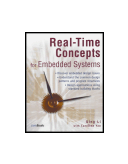
Master the fundamental concepts of real-time embedded system programming and jumpstart your embedded projects with effective design and implementation practices. This book bridges the gap between higher abstract modeling concepts and the lower-level programming aspects of embedded systems development. You gain a solid understanding of real-time embedded systems with detailed practical examples and industry wisdom on key concepts, design processes, and the available tools and methods.
Delve into the details of real-time programming so you can develop a working knowledge of the common design patterns and program structures of real-time operating systems (RTOS). The objects and services that are a part of most RTOS kernels are described and real-time system design is explored in detail. You learn how to decompose an application into units and how to combine these units with other objects and services to create standard building blocks. A rich set of ready-to-use, embedded design “building blocks” is also supplied to accelerate your development efforts and increase your productivity.
Experienced developers new to embedded systems and engineering or computer science students will both appreciate the careful balance between theory, illustrations, and practical discussions. Hard-won insights and experiences shed new light on application development, common design problems, and solutions in the embedded space. Technical managers active in software design reviews of real-time embedded systems will find this a valuable reference to the design and implementation phases.
Qing Li is a senior architect at Wind River Systems, Inc., and the lead architect of the company’s embedded IPv6 products. Qing holds four patents pending in the embedded kernel and networking protocol design areas. His 12+ years in engineering include expertise as a principal engineer designing and developing protocol stacks and embedded applications for the telecommunications and networks arena. Qing was one of a four-member Silicon Valley startup that designed and developed proprietary algorithms and applications for embedded biometric devices in the security industry.
Caroline Yao has more than 15 years of high tech experience ranging from development, project and product management, product marketing, business development, and strategic alliances. She is co-inventor of a pending patent and recently served as the director of partner solutions for Wind River Systems, Inc.
About the Authors
3.4.2 RTOS Initialization
3.4.2 RTOS Initialization
Step 4 of Figure 3.7 begins the RTOS software initialization. Key things that can happen in steps 4 to 6 include:
1. initializing the RTOS
2. initializing different RTOS objects and services, if present (usually controlled with a user-configurable header file):
? task objects
? semaphore objects
? message-queue objects
? timer services
? interrupt services
? memory-management services
3. creating necessary stacks for RTOS
4. initializing additional RTOS extensions, such as:
? TCP/IP stack
? file systems
5. starting the RTOS and its initial tasks
The components of an RTOS (for example, tasks, semaphores, and message queues) are discussed in more detail in later chapters of this book. For now, note that the RTOS abstracts the application code from the hardware and provides software objects and services that facilitate embedded-systems application development.




